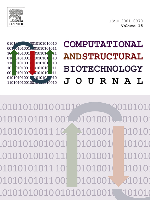
Computational and Structural Biotechnology Journal
Scope & Guideline
Unveiling Breakthroughs in Biochemistry and Genetics via Structural Biotechnology
Introduction
Aims and Scopes
- Computational Modeling in Biotechnology:
Research that employs computational techniques to model biological processes, predict molecular interactions, and optimize biotechnological applications. - Structural Biology Applications:
Studies focusing on the structural characterization of biomolecules, including proteins, nucleic acids, and complexes, to understand their functions and interactions. - Machine Learning and AI in Bioinformatics:
Utilization of machine learning and artificial intelligence to analyze biological data, improve predictive models, and facilitate drug discovery processes. - Omics Integration:
Integration of various omics data (genomics, transcriptomics, proteomics, and metabolomics) to uncover complex biological networks and interactions. - Microbial and Environmental Biotechnology:
Research on microbial systems and their applications in biotechnology, including metabolic engineering and environmental sustainability. - Drug Discovery and Development:
Focused studies on the discovery and design of novel therapeutics, including the use of computational approaches to identify drug targets and design inhibitors. - Systems Biology:
Research employing systems biology approaches to understand the dynamic interactions within and between biological systems.
Trending and Emerging
- AI and Machine Learning Applications:
A surge in research applying AI and machine learning techniques to various biological problems, including drug discovery, molecular modeling, and predictive analytics. - Integration of Multi-Omics Data:
An increasing trend in studies that integrate multi-omics data to provide comprehensive insights into biological processes and disease mechanisms. - Structural Dynamics and Flexibility Studies:
Growing interest in understanding the dynamic behavior of proteins and other biomolecules, moving beyond static structures to explore conformational changes and their functional implications. - Microbiome and Host Interactions:
A rising focus on the role of microbiomes in health and disease, exploring the complex interactions between host organisms and their microbial communities. - Sustainable Biotechnology Practices:
Emerging research on sustainable practices in biotechnology, including the use of microbial systems for bioremediation and bioenergy production. - Computational Drug Repurposing:
Increased studies on computational methods for drug repurposing, particularly in light of the COVID-19 pandemic, indicating a shift towards rapid therapeutic development.
Declining or Waning
- Traditional Biochemical Assays:
There is a noticeable decline in papers focusing solely on traditional biochemical assays, as the field shifts towards more integrated computational and structural approaches. - Basic Laboratory Techniques:
Research emphasizing basic laboratory techniques without computational integration is less frequent, indicating a trend towards more sophisticated, data-driven methodologies. - Single-Method Studies:
Papers focusing on single-method approaches, such as solely experimental or purely computational, are decreasing as interdisciplinary approaches become the norm. - Static Structural Analysis:
Research concentrating on static structural analysis of proteins without considering dynamic properties or interactions is waning, reflecting a growing recognition of the importance of molecular dynamics.
Similar Journals

Current Research in Structural Biology
Connecting Researchers to the Latest in Structural BiologyCurrent Research in Structural Biology, published by Elsevier, is a pioneering Open Access journal that has rapidly gained prominence since its inception in 2019. With a focus on advancing the understanding of molecular and structural biology, this journal provides a platform for researchers and professionals to publish groundbreaking findings that contribute to the field's ongoing development. With a commendable Q2 ranking in both Molecular Biology and Structural Biology categories for 2023, it serves as a vital resource for the community, ensuring accessibility to high-quality research. The journal is indexed in Scopus, showcasing its significant impact and relevance, particularly with a ranking of #26/49 in the Structural Biology discipline. Located in the heart of the Netherlands, Current Research in Structural Biology not only fosters academic discourse but also encourages collaborative research efforts in addressing critical biological questions. Whether you are a researcher, student, or industry professional, this journal is essential for staying abreast of the latest advancements and trends in structural biology.

FEBS Open Bio
Unlocking the potential of open-access scientific discovery.FEBS Open Bio is a leading open-access journal published by Wiley, dedicated to advancing our understanding of biochemistry, genetics, and molecular biology. Since its inception in 2011, this journal has provided a robust platform for researchers to share their findings with a wider audience, ensuring the dissemination of high-quality scientific knowledge. With an impact factor reflecting its stature in its field, FEBS Open Bio is ranked #77 out of 221 in general biochemistry, genetics, and molecular biology, placing it in the 65th percentile among its peers. This journal serves as an essential resource for professionals, researchers, and students alike, fostering collaboration and innovation within the scientific community. The commitment to open access not only enhances visibility but also promotes transparency in research, making it a vital contributor to the ongoing dialogue in biochemical and molecular biological sciences. For those looking to stay at the forefront of research developments, FEBS Open Bio is a key publication addressing the latest trends and discoveries in the field.

PLoS Computational Biology
Unlocking Insights Through Computational InnovationPLoS Computational Biology is a premier open-access journal published by the Public Library of Science, committed to advancing the understanding of complex biological data through computational approaches. Since its inception in 2005, the journal has made significant strides in the fields of Cellular and Molecular Neuroscience, Computational Theory and Mathematics, Ecology, Genetics, and Molecular Biology, achieving a notable Q1 ranking in various categories as of 2023. With an exceptional impact factor and an esteemed ranking—such as Rank #23/176 in Computational Theory and Mathematics—PLoS Computational Biology provides a vital platform for researchers, professionals, and students to disseminate their cutting-edge findings and insights. The journal's open-access model ensures that high-quality research is freely accessible worldwide, fostering collaboration and innovation across disciplines. Located in San Francisco, CA, it serves as a hub for the global scientific community, making it an indispensable resource for anyone at the forefront of computational biology and its diverse applications.

IUBMB LIFE
Illuminating Pathways in Biochemistry and GeneticsIUBMB LIFE is a prestigious, peer-reviewed journal published by WILEY, dedicated to advancing the fields of biochemistry, molecular biology, and cell biology. With an impressive impact factor and consistently ranked in the Q1 and Q2 categories across multiple relevant disciplines—including Biochemistry, Genetics, and Clinical Biochemistry—this journal has established itself as a leading platform for disseminating innovative research and critical reviews that propel scientific discovery. The journal spans a converged publication period from 1999 to 2024, providing comprehensive insights into the dynamic landscape of biochemical research. Researchers, professionals, and students alike are invited to explore its Open Access options, ensuring that groundbreaking studies are accessible to a global audience. As it continues to shape the future of life sciences, IUBMB LIFE remains a vital resource for those seeking to enrich their understanding and contribute to these rapidly evolving fields.

CRITICAL REVIEWS IN BIOCHEMISTRY AND MOLECULAR BIOLOGY
Elevating Insights in Molecular BiologyWelcome to Critical Reviews in Biochemistry and Molecular Biology, a premier academic journal published by Taylor & Francis Ltd, dedicated to advancing the fields of biochemistry and molecular biology. With an impressive impact factor and a Q1 ranking in both Biochemistry and Molecular Biology for 2023, this journal serves as a vital resource for researchers, professionals, and students eager to engage with cutting-edge reviews and analyses that synthesize the latest developments in these dynamic areas of study. Since its inception in 1972, the journal has maintained a commitment to high-quality scholarship, providing a platform for critical discussions that accelerate the discovery and understanding of biochemical processes and molecular interactions. Although not open access, its robust editorial peer-review process ensures that published articles meet the highest standards of scientific rigor, making it a trusted source for the scientific community. As we continue to converge toward 2024, we invite you to explore the extensive array of topics and findings that have shaped contemporary biochemistry and molecular biology.

Synthetic and Systems Biotechnology
Connecting Disciplines for Revolutionary InsightsSynthetic and Systems Biotechnology, published by KEAI PUBLISHING LTD, is a pioneering open-access journal that has made significant contributions to the fields of applied microbiology, biotechnology, biomedical engineering, genetics, and structural biology since its inception in 2016. With an ISSN of 2405-805X, this journal is committed to fostering innovative research and interdisciplinary collaboration, providing a platform for the dissemination of high-quality studies that push the boundaries of scientific knowledge. Recognized for its excellence, it holds prestigious Q1 rankings in both Applied Microbiology and Biotechnology as well as Biomedical Engineering in 2023, alongside notable Q2 rankings in Genetics and Structural Biology. Researchers, professionals, and students alike can access cutting-edge research that explores the dynamic interplay between synthetic biology and systems biology, driving advancements that could reshape health, industry, and environmental sustainability. By operating under an open-access model, Synthetic and Systems Biotechnology ensures that new findings are accessible to a global audience, thereby maximizing the impact and reach of the published work and paving the way for future discoveries.

AIMS Biophysics
Empowering researchers with open access to groundbreaking findings.AIMS Biophysics, published by the American Institute of Mathematical Sciences (AIMS), is an esteemed open-access journal dedicated to advancing the fields of biophysics, biochemistry, molecular biology, and structural biology. Launched in 2014, this journal provides a platform for researchers and professionals to disseminate high-quality research findings that contribute to the understanding of complex biological systems at the molecular level. With an ISSN of 2377-9098, AIMS Biophysics is indexed in Scopus, where it ranks in the fourth quartile across several categories, reflecting its commitment to addressing important issues within the scientific community. The journal aims to foster interdisciplinary collaboration and innovation through the publication of original research, reviews, and methodologies that advance the field. The open-access model ensures that cutting-edge research is freely available, promoting global access to scientific knowledge and enhancing visibility for authors. Nestled in the vibrant scientific landscape of the United States, AIMS Biophysics is poised to impact the evolving discourse in biophysics and related areas as it continues through its convergence period from 2014 to 2024.

Biotechnology and Genetic Engineering Reviews
Reviewing Breakthroughs in Genetic Engineering and Biotech.Biotechnology and Genetic Engineering Reviews is a prominent journal published by Taylor & Francis Ltd, specializing in the rapidly evolving fields of biotechnology and genetic engineering. Since its inception in 1984, this journal has served as a critical platform for researchers and professionals to disseminate groundbreaking scientific findings, review methodologies, and discuss emerging trends within the domain. With a substantial track record of convergence in its publication history from various years, it currently holds Q2 rankings in both Bioengineering and Biotechnology, alongside a Q3 ranking in Molecular Biology for 2023. Its dedication to quality research is reflected in its Scopus rankings, which position the journal favorably within the competitive landscape of biochemistry and molecular biology. Although it is not an open-access journal, Biotechnology and Genetic Engineering Reviews remains committed to providing accessible insights to the global scientific community, making it an invaluable resource for students, academics, and industry professionals keen on advancing their knowledge in these crucial fields.

Frontiers in Bioinformatics
Connecting Ideas, Driving Innovation in BioinformaticsFrontiers in Bioinformatics is a leading academic journal dedicated to advancing the field of bioinformatics by publishing high-quality research and review articles. Published by FRONTIERS MEDIA SA, this open-access journal aims to foster innovative research, promote collaborative initiatives, and provide a platform for the dissemination of findings related to computational biology, biostatistics, and the intersection of bioinformatics with other biological disciplines. With a focus on promoting accessibility and visibility of research, Frontiers in Bioinformatics operates under a rigorous peer-review process, ensuring that all published content meets the highest academic standards. The journal has shown a commendable rank across various Scopus categories, including Mathematics, Computational Mathematics, and multiple dimensions of Biochemistry and Molecular Biology, indicating its relevance and impact within the research community. Researchers, professionals, and students will find this journal invaluable for staying abreast of the latest developments and breakthroughs in bioinformatics, enhancing their studies and professional projects.

ACS Bio & Med Chem Au
Pioneering interdisciplinary studies that shape the future of medicine.ACS Bio & Med Chem Au, published by the esteemed American Chemical Society, stands at the forefront of interdisciplinary research within the realms of biochemistry, drug discovery, pharmaceutical sciences, and molecular biology. With an impressive Impact Factor indicative of its rigorous academic standards and significant contributions to the field, this open-access journal is committed to disseminating high-quality research that drives innovation and advancements in biosciences and medicinal chemistry. Since its inception in 2021, the journal has rapidly earned recognition, achieving a commendable Q1 ranking in multiple categories, including Biochemistry, Drug Discovery, and Pharmaceutical Science, while also making strides in Molecular Biology. Researchers, professionals, and students alike can explore pioneering studies that bridge gaps between laboratory research and clinical applications, fostering collaborative efforts towards novel therapeutic strategies. With a focus on enhancing accessibility and engagement within the scientific community, ACS Bio & Med Chem Au is poised to impact the future of biomedical research significantly.